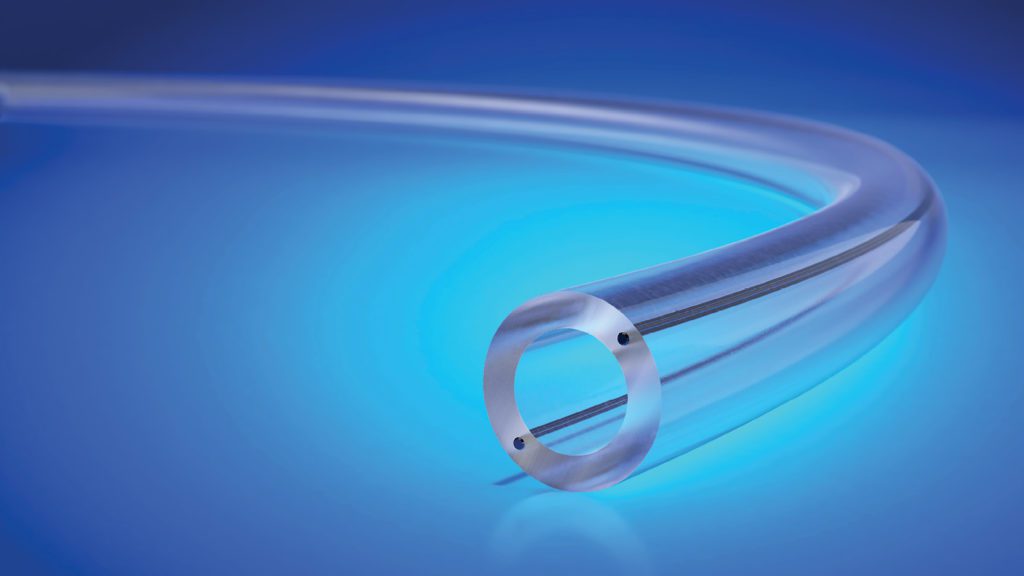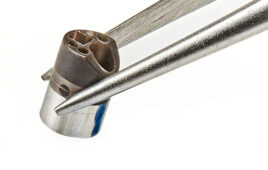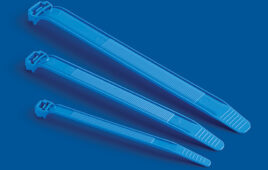The health outcomes that minimally invasive surgical devices provide – shorter hospital stays and recovery periods – are as remarkable as the micro-manufacturing methods that produced the devices.

The micro-molded and micro-extruded parts from Raumedic, provide examples of the technology. For instance, the small ball shaped end on the white tube is an over-molded part with a shot size of 0.004 g. The pointed parts to the right include fenestrated tips, holes formed by mold features, not in a secondary operation.The health outcomes that minimally invasive surgical devices provide – shorter hospital stays and recovery periods – are as remarkable as the micro-manufacturing methods that produced the devices.
Micro-manufacturing involves more than making conventional tooling smaller. Micro-extrusions and micro-molding also involve ultra-fine wires and electronic components.
Helmbrechts, Germany-based Raumedic, which has its U.S. headquarters in Mills River, N.C., has been touting its capabilities when it comes to ultra-small dimensioned tubing and molded parts. The company even has a motto around its marketing efforts: “Think small.”
“Micro-extrusions can have inner diameters of 0.004 in. with wall thicknesses of 0.002 in., and coatings can have micro-layers as thin as 0.0002 in.,” explained Rudi Gall, a vice president at Raumedic.
Micro-molding generally involves components with sizes or tolerances so small that suppliers can’t make them correctly or with a high degree of precision using traditional injection-molding equipment. “More specifically, micro-molded parts have a typical range from 1 g to less than 0.004 g. Dimensional tolerances required are often much tighter than ±0.001 in.,” noted Gall.

The co-extruded tubing with embedded wires improves the tube’s kink resistance. A wide variety of wire materials and polymer combinations can be adapted to an application.
“Although the molding equipment has improved in recent years, coating and over-molding features require a high skill level from the machine operator,” he said.
Here are 5 things, courtesy of Raumedic’s Gall, that medical device designers and engineers should consider when going the micro-manufacturing route:
1. Understand the material’s characteristics
Before launching production of a micro part, Gall suggests getting input from the material supplier and a manufacturer’s engineering team. For example, he said, semi-crystalline or amorphous resins, fillers and fibers, and even colorants can all impact the product consistency required to meet critical dimensional requirements. Selecting the right material is a foundation for long-term manufacturability. Use consistent amorphous engineering-grade resins for tight tolerances, and apply fillers for added dimensional stability where necessary.
2. Go beyond general part design principals
Gall further recommended that for a successful design, follow general part design principals. Micro-molding, he added, requires meeting or exceeding these guidelines. “For example, in a conventional part, slight areas of sink, in ribs, slight warpage in sharp corners, or flowing thin-to-thick may cause minor problems. But in a small part, such flaws are disastrous and result in deformation that can exceed the allowable tolerance.”
3. It’s all about the details
Be prepared to disclose shot weights, material selections, part size and critical features, Gall said. Shot control may exceed what is possible for a check-ring screw. A plunger or ram may best fit an application. Consistency is key to long-term success.
4. Have you considered multilayer tubing?
Multilayer tubing is another design possibility that offers a practical solution for various medical applications, according to Gall. “The tubing provides an inert material on the inside for drug-delivery applications and a bondable outer layer. The trick is keeping the co-extruded layers within a specified tolerance range.”
Gall said Raumedic engineers have also developed processing capabilities to co-extrude a wide variety of metal wires and glass fibers within the tubing walls.
“When necessary, it is possible to co-extrude and work with copper, stainless steel, nitinol, platinum alloys, nickel, and silver plated wires in combination with a variety of polymers,” Gall said. The materials include polypropylene, polyethylene, nylon, polyurethane, and silicone, as well as high-performance resins (FEP, PEEK, PPSU, PEI and PTFE Moldflon). The PTFE Moldflon is significant because it resists the flaking and cracking common to recent PTFE formulation when applied to wires.
5. Explore co-extrusion of wires.
Also consider that many medical products call for hand-stringing wires, cables and coils though multi-lumen tubing, which can be labor-intensive. Gall said that device companies can avoid extra labor by co-extruding wires within the tubing walls to significantly reduce fabrication costs. The wires provide kink resistance, but also serve as a path for sensor signals and data transfer from the device and patient to an analytical or diagnostic system. The latter is used in neuro-monitoring devices, electromagnetic positioning systems, and cochlear implant hearing devices.

A Colpotransilluminator (the dual diameter item to the right) and vacuum hose produced by RAUMEDIC are used in a gynecological application. The assembly illustrates the manufacturing trend and several processing techniques. The tubing set consists of various tubes, fittings, clamp, and bonds applied in multiple production steps.
It is important to also note that medical device manufacturing trends have component manufacturers delivering more than parts: OEMs want more complete product sets. Gall cited a colpotransilluminator as an example. All of its components are produced in-house, making it easier to control manual and customized-tool-supported processing techniques such as extrusion, molding, cutting and assembly (bonding). The tubing set ensures a hygienic and minimally invasive procedure, and residue-free suctioning of the wound secretion provides healing in a shorter period than previously possible.
[Want to stay more on top of MDO content? Subscribe to our weekly e-newsletter.]




